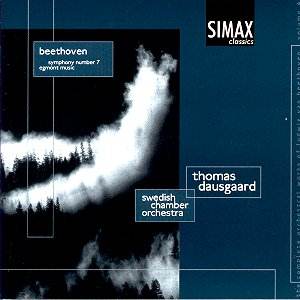This interesting pairing of the Seventh Symphony with the complete
Egmont incidental music makes for exciting listening. The dramatic aspect
of Beethoven the symphonist is always high on the agenda and so it proves
here, although not necessarily for the usual reasons. Dausgaard certainly
has the measure of the music - in both pieces - and drives it particularly
hard. And this music can take such an approach - in fact it suits the
Seventh Symphony very well, particularly in the driving intensity of
the outer movements.
However, the decisions on tempi may have had something to do with the
nature of using the relatively small string body of the Swedish Chamber
Orchestra. For if the performances (and that of the symphony especially)
have a weakness it is the lack of bloom in the string sound. Of course
such things may stem from the combination of the performance and the
recording, but the latter seems highly satisfactory and therefore the
temptation is to suggest that the thin string sound is the result of
a relatively small ensemble: the highly informative insert notes list
the whole ensemble as 38 players. Without extra doublings in the winds,
this would mean a total of 25 strings. And the photograph on the back
of the booklet suggests only two double basses. Therefore the string
sound will have its limitations in terms of bloom, even if it also has
its strengths in terms of attack and accuracy.
Since there is no real slow movement in the Seventh Symphony - the
second movement is an Allegretto - the lively driving pace of Dausgaard's
performance makes its exciting mark. If anything it intensifies the
salient characteristic of the music, as described by Wagner: the apotheosis
of the dance. The lack of full string tone may worry some people more
than others, but it is not a problem of the playing, merely a decision
central to the interpretation. And this interpretation is nothing if
not compelling.
The same might also be said of the Egmont music. Here the competition
is nothing like as fierce, of course, and the intensity of the performance
catches just the right tone. The vision is central to Beethoven's aesthetic:
a wronged man in his prison cell bravely overcoming fear of his looming
execution by conjuring noble thoughts of his lover and an idealised
vision of freedom.
Dausgaard's blazing performance of the Overture sets the pulse racing,
and the less well known numbers which follow maintain the tension in
their various ways. Henriette Bonde-Hansen sings her two numbers with
refined judgement and is captured in just the right recorded balance.
This is an imaginative coupling, performed with drive and a real insight
into the fundamental nature of both works. If a chamber orchestra sound
is acceptable to you, then the recommendation becomes confident, even
urgent.
Terry Barfoot

![]() Henriette Bonde-Hansen
(soprano)*
Henriette Bonde-Hansen
(soprano)*![]() SIMAX Classics PSC 11822
[69.46]
SIMAX Classics PSC 11822
[69.46]